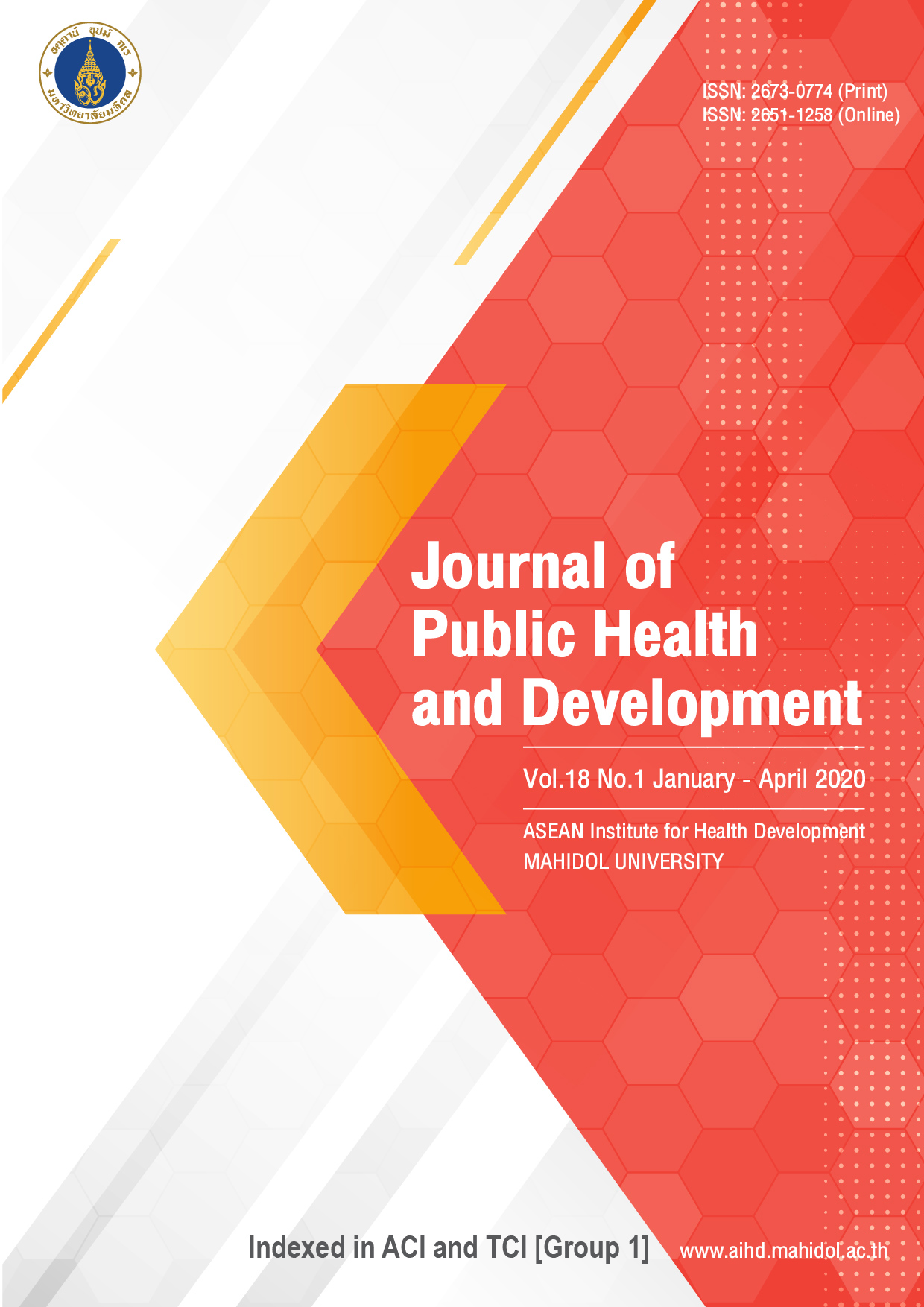Factors of primary dysmenorrhea in junior high school students in South Tangerang City, Indonesia, 2018.
Main Article Content
Abstract
Primary dysmenorrhea is painful menstruation that occurs without the gynecological disease, and it can spread towards the waist and thighs, along with pain, nausea, vomiting, headaches, diarrhea and can interfere with daily activities. In Indonesia, it is estimated that about 72.89% of adolescent experienced primary dysmenorrhea. This study aimed to prove the factors of primary dysmenorrhea in Junior High School Students in South Tangerang City, Indonesia, 2018. The design of the study was cross-sectional. Two hundred and forty-six students were taken by proportional random sampling. Data were collected by a questionnaire including personal information, prevalence, symptoms, degrees, handling and risk factors of primary dysmenorrhea. The result of this study showed that the prevalence of dysmenorrhea had 80.9%. The most characteristics of the students at age of menarche ≥ 12 years old (61.0%), length of menstruation ≤ 7 days (75.6%), with family history (69.1%), the less physical activity (58.5%), severe-extremely of the stress levels (52.0%), normally BMI (41.1%). There was a statistical correlation between dysmenorrhea to an age of menarche, stress levels, physical activity and family history of dysmenorrhea. There was no statistical correlation between dysmenorrhea to BMI and length of menstruation. The conclusion is dysmenorrhea commonly happen in junior high school students in South Tangerang City, which are determined by several factors, and it interferes with daily activities. Recommended for female students and the schools are more in-depth education related to reproductive health, especially to primary dysmenorrhea.
Article Details
References
Nahal Habibi, MSc, Mary Soo Lee Huang, Ph.D., et al. Prevalence of Primary Dysmenorrhea and Factors Associated with Its Intensity among Undergraduate Students: A Cross-Sectional Study. Pain Management Nursing. 2015. 16(6): 855-861.
Prawirorahardjo. Ilmu Kandungan Jakarta. Jakarta: Yayasan Bina Pustaka Sarwono Prawirohardjo. 2007.
Bickley, Lynn S. Buku Ajar Pemeriksaan Fisik Dan Riwayat Kesehatan. 8th Edition. Jakarta: EGC. 2009. 4,3.
Febriana, dkk. Hubungan tingkat Aktivitas Fisik dengan Dysmenorrhea Primer pada Remaja Umur 13-15 tahun di SMP K. Harapan Denpasar. Kementrian Pendidikan dan Kebudayaan Program Studi Fisioterapi Fakultas Kedokteran Udayana. 2015. 5-6
Kristianingsih. Risk Factors of Primary Disminore in Junior High School in District Natar of South Lampung. Jurnal Aisyah. 2016. 1(1).
Wang, L, et al. Stress and Dysmenorrhea: A Population-Based Prospective Study. Occupational and Environmental Medicine. 2008. 61 (12): 1021-1026.
Abbaspour, Z et al. The Effect of Exercise on Primary Dysmenorrhea. Res Health Sci Journal. 2005. 4(2): 26-31
Mahvash, et al. The Effect of Physical on Primary Dysmenorrheal of Female University Students. World Applied Sciences Journal. 2012. 17(10): 1246-1252,1012
Yuliani, Pungkas & Hidayati, Novita Nur. 2011. Hubungan Antara Dismenorea dengan Aktivitas Belajar Siswa SMP N 4 Boyolali. Jurnal Kebidanan. 3(2)
Ministry of Education and Culture, Indonesia
Derseh BT, Affesa N, et al. prevalence Dysmenorrhea and its Effects on School Performance: A Cross-Sectional Study. J Women's Health Care. 2017. 6:361
Kazama M, Maruyama K, Nakamura K. Prevalence of Dysmenorrhea and its Correlating Life Factors in Japanese Female Junior High School Students. PubMed. 2015. 236(2): 107-13
Tinatin Gagua, Besarion Thkeshelashvili, David Gagua. Primary Dysmenorrhea: Prevalence in Adolescent Population of Tblisi, Georgia and Risk Factors. 2012. 13(3): 162-168.
Manuaba, I. B. G. Memahami kesehatan reproduksi wanita (2 ed.). Jakarta: EGC. 2009.
Ratna Ningsih, Setyowati, Hayuni Rahmah. Efektivitas Paket Pereda Nyeri pada Remaja dengan Dismenore. Jurnal Keperawatan Indonesia. 2013. 16(2): 67-76.
Unsal, Alaettin, dkk. 2010. Prevalence of Dysmenorrhea its effect on Quality of Life among a Group of Female University Students. Upsala Journal of Medical Sciences; 115: 138-145
MoolRaj Kural, Naziya Nagori Noor, et al. Menstrual Characteristics and Prevalence of Dysmenorrhea in College Going Girls. Journal of Medicine and Primary Care. 2015. 4(3): 426-431
Sinaga, Ernawati dkk. Manajemen Kesehatan Menstruasi. Universitas Nasional IWWASH. Global One. 2017.
Naheed Parveen, Rehana Majeed, Mansoor Ali Khawaja. Evaluation of Breast Feeding Practices. Gomal Journal of Medical Sciences. 2009. 7(1).
Andriani, Y. 2015. Hubungan Indeks Massa Tubuh, Tingkat Stress, Dan Aktivitas Fisik Dengan Tingkat Dismenore Pada Mahasiswa D III Kebidanan Semester Ii Stikes ‘Aisyiyah Yogyakarta. Yogyakarta: Program Studi Bidan Pendidik Jenjang D IV Sekolah Tinggi Ilmu Kesehatan‘Aisyiyah Yogyakarta
Isnaeni, D.N. Hubungan Antara Stres Dengan Pola Menstruasi Pada Mahasiswa D IV Kebidanan Jalur Reguler Universitas Sebelas Maret Surakarta. 2010.
Shinta, O.D., Sirait., Hiswani., Jemadi. Faktor-Faktor yang Berhubungan dengan Kejadian Dismenore pada Siswi SMA Negeri 2 Medan Tahun 2014. [Karya Tulis Ilmiah]. Medan: Fakultas Kesehatan Masyarakat. USU Medan. 2014.
Kristina. 2010. Dismenore primer. Jakarta : Balai Pustaka
Castellsague J, Pisa F, Rosolen V, et al. 2013. Risk of upper gastrointestinal complications in a cohort of users of nimesulide and other nonsteroidal anti-inflammatory drugs in Friuli Venezia Giulia, Italy. Pharmacoepi¬demiol Drug Saf. 22(4):365–375.
Schorge JO et al. 2008. Williams gynecology, New York. McGraw-Hill.
Sulistyowati dkk. 2009. Dasar-Dasar Ilmu Kesehatan Masyarakat Dalam Kebidanan, Fitramaya, Yogyakarta.
Nurwana dkk. 2016. Analisis Faktor yang Berhubungan dengan Kejadian Dismenorea pada Remaja Putri di SMA Negeri 8 Kendari Tahun 2016. Jurnal Ilmiah Mahasiswa Kesehatan Masyarakat. Vol. 2 No.6. ISSN 250-731X.
Baranitharan R, Mahalaxmi V, Koki la V. 2010. Physiotherapy care of Womens Health. Jaypee Brothers Medical Publisher. Pg.No. 52-54


